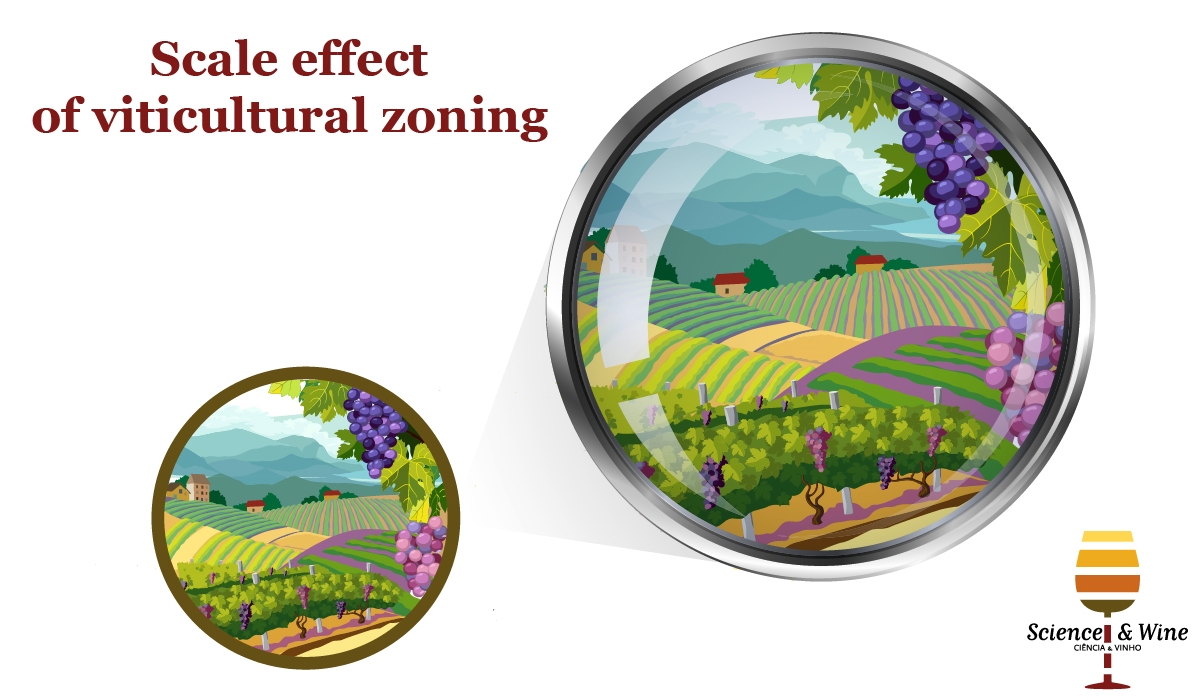By Simone Priori
The terroir effect on wine is one of the most debated issue in the world of wine, because of the complicated interaction between natural and human factors. Beside the human factor, which plays the most important role through viticultural and oenological practices, the soil and climate factors are most important in the expression of terroir, and they may vary depending on the spatial scale. At regional scale, climate in interaction with the grapevine cultivar is the most important (Jones et al., 2005), whereas at “wine district scale”, the interaction between mesoclimate, topography and geology might be the dominant factor for grape and wine peculiarities (Van Leeuwen et al., 2004; Priori et al., 2014; Ramos et al., 2015). At farm and vineyard scale, the micro-climate, the soil features, especially the soil hydrology, become much more important to differentiate the grape peculiarities (Costantini et al., 2009; Bramley et al., 2011; Priori et al., 2013; Bonfante et al., 2015; Tardaguila et al., 2017). The object of this post is to present the results of a very recent paper aimed to investigate the effect of macro-terroir and basic terroir units (UTB) on wine peculiarities under three contrasting vintages (Priori et al., 2019).
The vineyards studied for this work belong to Barone Ricasoli estate, one of the largest and oldest farms in the Chianti Classico wine district, Tuscany. These vineyards are situated in three of the most important and representative macro-terroir (MT) of the Chianti Classico wine districts (Fig. 1), which are: i) CALC- calcareous, clayey and stony soils on hills at medium altitude (350-450 m a.s.l.) characterized by calcareous flysch (limestone and shales) of the Monte Morello Fm.; ii) SAND- sandy and stony soils, non-calcareous, on hills at medium altitude (400-450 m a.s.l.), characterized by sandstone of Macigno fm. (SAND); iii) MAR- sandy-loamy soils, at lower altitude (300-350 m a.s.l.) formed from marine sandy gravelly deposits of the Pliocene period. In addition, a macro-terroir more specific for this farm was selected on ancient fluvial terraces (FLUV) characterized by calcareous, loamy and stony soils at low altitude (250-300 m a.s.l.).
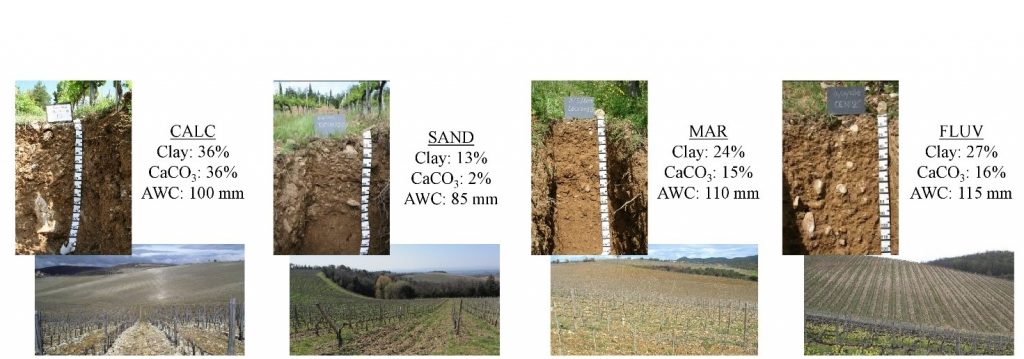
The study was carried out in 12-16 years old Sangiovese cv. vineyards, the vine density varies between 6200 and 6600 vines/ha, and the trellis system was the simple spurred cordon with vertical shoot. The experimental vineyards received the same viticultural treatments during the growing season. Each MT was subdivided into two 1.5-2 ha size UTB by cluster analysis, using proximal soil sensing data obtained by electromagnetic induction sensor and gamma-ray spectrometer (Fig.2). Apparent electrical conductivity (ECa), measured by electromagnetic induction sensor, is more related to soil texture, stoniness, and soil depth until depth of about 1.5 m, whereas gamma-ray spectra are related to parent material mineralogy, soil texture, stoniness, and calcium carbonate of the topsoil (0-30 cm). Therefore, the couples of UTB within each MT were mainly distinguished by texture, stoniness, and then associated hydrological features like available water capacity (AWC) and internal drainage.
Within each UTB, three representative soil profiles of about 1.5 m were dug, to characterize the main soil features and grapevine root distribution. Small areas with deep and too fertile soils, or subject to waterlogging or exceptional soil erosion, were excluded. The grape from each UTB was harvested and vinified separately, using the same methods, in a tank of 80 hl and then in 5 hl oak barrel (tonneaux) for a 6-months aging. The wines were analysed and evaluated by a panel of 10 wine tasters through a “blind tasting”. Sensory analysis was mainly comparative, aimed to assess the differences among the wines. The wine tasters gave a score, ranging from 1 to 10 to several wine parameters, giving score 10 to the wine which best expressed the parameter. In addition, the tasters indicated their feeling about the wine in terms of aroma typology (fruity, floral, spicy, herbaceous), using 0-absent, 1-scarce, 2-medium, and 3-strong.
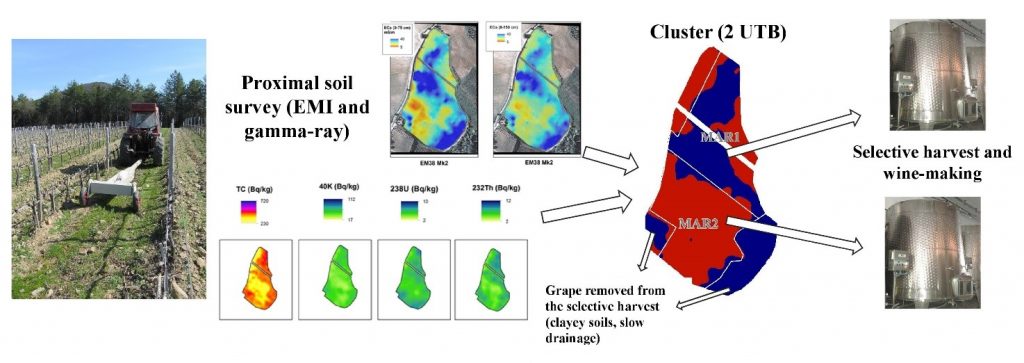

The study was carried out in 12-16 years old Sangiovese cv. vineyards, the vine density varies between 6200 and 6600 vines/ha, and the trellis system was the simple spurred cordon with vertical shoot. The experimental vineyards received the same viticultural treatments during the growing season. Each MT was subdivided into two 1.5-2 ha size UTB by cluster analysis, using proximal soil sensing data obtained by electromagnetic induction sensor and gamma-ray spectrometer (Fig.2). Apparent electrical conductivity (ECa), measured by electromagnetic induction sensor, is more related to soil texture, stoniness, and soil depth until depth of about 1.5 m, whereas gamma-ray spectra are related to parent material mineralogy, soil texture, stoniness, and calcium carbonate of the topsoil (0-30 cm). Therefore, the couples of UTB within each MT were mainly distinguished by texture, stoniness, and then associated hydrological features like available water capacity (AWC) and internal drainage.
Within each UTB, three representative soil profiles of about 1.5 m were dug, to characterize the main soil features and grapevine root distribution. Small areas with deep and too fertile soils, or subject to waterlogging or exceptional soil erosion, were excluded. The grape from each UTB was harvested and vinified separately, using the same methods, in a tank of 80 hl and then in 5 hl oak barrel (tonneaux) for a 6-months aging. The wines were analysed and evaluated by a panel of 10 wine tasters through a “blind tasting”. Sensory analysis was mainly comparative, aimed to assess the differences among the wines. The wine tasters gave a score, ranging from 1 to 10 to several wine parameters, giving score 10 to the wine which best expressed the parameter. In addition, the tasters indicated their feeling about the wine in terms of aroma typology (fruity, floral, spicy, herbaceous), using 0-absent, 1-scarce, 2-medium, and 3-strong.
The climatic conditions were very variable during the three experimental vintages, from very warm and dry (2012), on average with long term climate (2013), and colder and more humid than the average (2014). The contrasting climate conditions that occurred during the three experimental years determined vintage-to-vintage differences in the grape and wine quality (Fig.3). The coldest and most humid summer of 2014 provided poor differentiations between wines, hiding the terroir effect, at MT scale and, especially between the couples of UTB. On the contrary, during the warmest and driest summer of 2012, the wines from the UTB couple within each MT showed the clearest differences.
In general, macro-terroir tends to have stronger effect on must pH, wine total acidity, glycerine and colour intensity, whereas climate conditions of the vintage stronger influence must malic acid, wine total polyphenols, anthocyanins and dry extract (Tab.1). A large amount of variance was also explained by the interaction between MT and climate of the vintage, especially dry extract and colour intensity.
The effect of UTB sub-division of the studied vineyards showed influence in wine colour and flavour intensity. Changing the zoning scale from MT to UTB according to soil physical and hydrological properties, appeared to have a significant effect only under dry summers, like in 2012 and, to a less extent, in 2013.
From the oenological and wine tasting results, the wine produced in the different UTB, belong to the four MT, showed the following peculiarities:
- Both the UTB situated in soils developed on clay-calcareous flysch (CALC) provided wines with general higher alcohol, total anthocyanins, dry extract and colour intensity than the average. Previous studies reported the same results for wines produced in the same macro-terroir (Scalabrelli et al., 2001; Priori et al., 2013).
- Loamy-sandy soils, non-calcareous, developed on feldspathic sandstone (SAND), provided wines characterized by light colour intensity and low acidity. SAND2, characterized by higher stoniness, and then soil macroporosity and faster drainage, provided wines with higher fruity flavour and general higher flavour intensity.
- Loamy-sandy soils, calcareous, developed on marine deposits (MAR) provided wines with low (MAR1) or medium (MAR2) alcohol, as well as low glycerine and dry extract. Moderate water deficit, which characterized MAR2 during the vintages 2012 and 2013, seems to play a key role to increase the flavour intensity of the wine, in particular for fruity and floral notes.
- Loamy and clay-loamy soils, calcareous, developed on ancient fluvial terraces (FLUV) made wines richer in alcohol, polyphenols, and glycerine, as well as high colour intensity. The effects of the two UTB within this MT is not still clear and strongly variable according to the vintage climate.
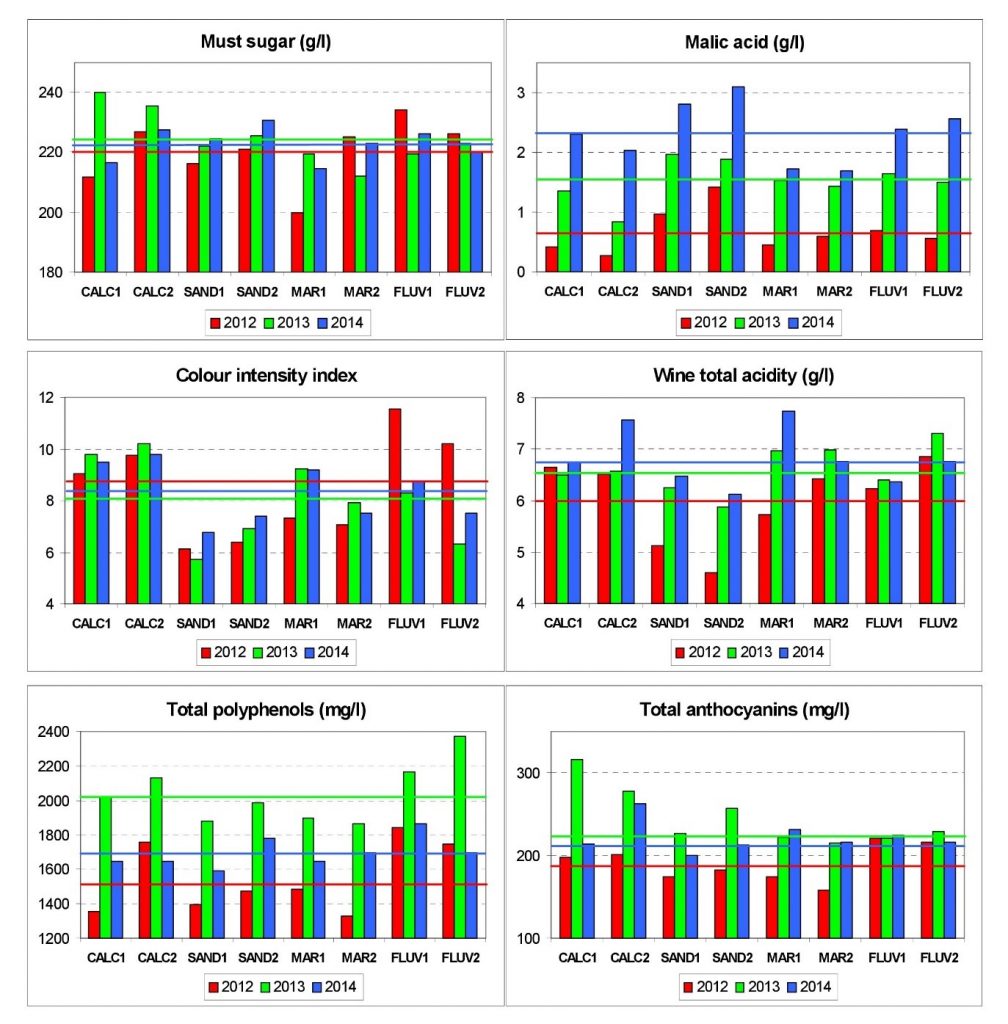
In conclusion, geology, soilscape and mesoclimate features, which characterize MT, drive some major wine peculiarities over time, while soil physical-hydrological features, which typify UTB within the same MT, play a key role on wine distinctiveness, mainly during dry vintages. The use of a more robust delineation of homogeneous areas, carried out using innovative techniques like proximal soil sensors, is fundamental to discriminate UTB. On the other hand, management of scattered and irregular UTB areas for selective harvest can be very difficult, or almost impossible, without a precision viticulture approach involving mechanical harvesters and GNSS.
Acknowledgements
I want to thank all the colleagues who collaborated to this work, in particular: Edoardo Costantini, Sergio Pellegrini, and Giuseppe Valboa (CREA-AA, Agriculture and Environment, Florence) and Paolo Storchi, Rita Perria, and Sergio Puccioni (CREA-VE, Viticulture and Eonology, Arezzo). Moreover, special thanks to “Barone Ricasoli” s.p.a. farm, who supported the work through VignaCRU project, and to the agricultural manager of the farm Massimiliano Biagi and co-workers (Fabio Cascella, Marco Cerqua, and Claudio Carapelli) for their support.
Those interested in a longer length report can download the working paper at:
https://www.sciencedirect.com/science/article/pii/S0016706118301599
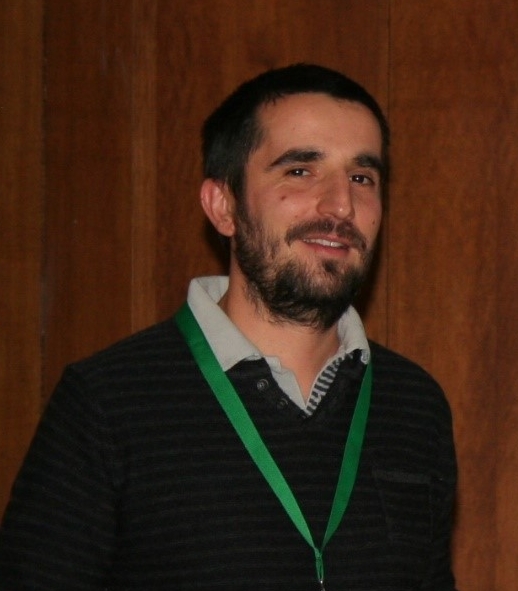
Simone Priori (simone.priori@crea.gov.it) is a researcher at CREA-AA, Research Centre of Agriculture and Environment in Florence (Italy), in the research group of “Database and Digital Soil Mapping Laboratory” (www.soilmaps.it). He received his Ph.D. from the University of Siena, Department of Earth Science in 2009, and since 2012 have permanent position at CREA. His research focused on pedology, digital soil mapping, and proximal soil sensing, especially applied to viticultural zoning and precision viticulture. He was vice-coordinator and project manager of the international project Core-Organic+ “Resolve” and scientific leader of several research projects funded by private stakeholders (wineries, consultants). He has published more than 25 papers in international scientific journals, many of which on the role of the soil in grape quality, soil management in vineyard, digital soil mapping for precision viticulture.
ORCID ID: https://orcid.org/0000-0002-9095-5833
References:
- Bonfante, A., Agrillo, A., Albrizio, R., Basile, A., Buonomo, R., De Mascellis, R., … & Manna, P., 2015. Functional homogeneous zones (fHZs) in viticultural zoning procedure: an Italian case study on Aglianico vine. Soil, 1(1), 427.
- Bramley, R. G. V., Ouzman, J., Thornton, C., 2011. Selective harvesting is a feasible and profitable strategy even when grape and wine production is geared towards large fermentation volumes. Australian Journal of Grape and Wine Research, 17(3), 298-305.
- Costantini, E.A.C., Pellegrini, S., Bucelli, P., Storchi, P., Vignozzi, N., Barbetti, R., Campagnolo, S., 2009. Influence of hydropedology on viticulture and oenology of Sangiovese vine in the Chianti area (Central Italy), Hydrol. Earth Syst. Sci. Discuss., 6, 1197-1231.
- Jones, G.V., White, M.A., Cooper, O.R., Storchmann, K., 2005. Climate change and global wine quality. Climatic Change, 73,3, 319-343.
- Priori, S., Martini, E., Andrenelli, M.C., Magini, S., Agnelli, A.E., Bucelli, P., Biagi, M., Pellegrini, S., Costantini, E.A.C., 2013. Improving wine quality through harvest zoning and combined use of remote and soil proximal sensing. Soil Sci. Soc. Am. J., 77(4), 1338-1348.
- Priori, S., Barbetti, R., L’Abate, G., Bucelli, P., Storchi, P., Costantini, E.A.C., 2014. Natural terroir units, Siena Province, Tuscany. Journal of Maps, 10-3, 466-477.
- Priori, S., Pellegrini, S., Perria, R., Puccioni, S., Storchi, P., Valboa, G., Costantini, E. A., 2019. Scale effect of terroir under three contrasting vintages in the Chianti Classico area (Tuscany, Italy). Geoderma, 334, 99-112.
- Ramos, M.C., Jones, G.V., Yuste, J., 2015. Phenology and grape ripening characteristics of cv Tempranillo within the Ribera del Duero designation of origin (Spain): Influence of soil and plot characteristics. European Journal of Agronomy, 70, 57-70.
- Scalabrelli, G., D’Onofrio, C., Ducci, E., Bertuccioli, M., 2001. Grapevine performances in five areas of Chianti Classico. Rev.S.Vitic. Arboric. Hortic. 33: 253-260.
- Tardaguila, J., Diago, M.P., Priori, S., Oliveira, M., 2017. Mapping and managing vineyard homogeneous zones through proximal geoelectrical sensing. Archives of Agronomy and Soil Science, 64(3), 409-418.
- Van Leeuwen, C., Friant, P., Chone, X., Tregoat, O., Koundouras, S., Dubourdieu, D., 2004. Influence of climate, soil, and cultivar on terroir. American Journal of Enology and Viticulture, 55(3), 207-217.

